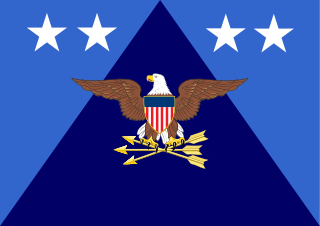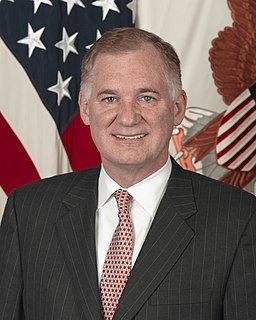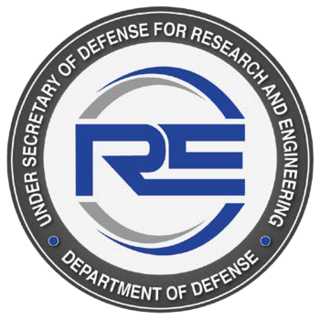
The secretary of defense (SecDef) is the leader and chief executive officer of the United States Department of Defense, the executive department of the U.S. Armed Forces. The secretary of defense's position of command and authority over the military is second only to that of the president of the United States, who is the commander-in-chief. This position corresponds to what is generally known as a defense minister in many other countries. The secretary of defense is appointed by the president with the advice and consent of the Senate, and is by custom a member of the Cabinet and by law a member of the National Security Council.

The deputy secretary of defense is a statutory office and the second-highest-ranking official in the Department of Defense of the United States of America.
The military budget is the largest portion of the discretionary United States federal budget allocated to the Department of Defense, or more broadly, the portion of the budget that goes to any military-related expenditures. The military budget pays the salaries, training, and health care of uniformed and civilian personnel, maintains arms, equipment and facilities, funds operations, and develops and buys new items. The budget funds five branches of the U.S. military: the Army, Marine Corps, Navy, Air Force and Space Force.

The Defense Finance and Accounting Service (DFAS) is an agency of the United States Department of Defense (DOD), headquartered in Indianapolis, IN. DFAS was established in 1991 under the authority, direction, and control of the Under Secretary of Defense (Comptroller)/Chief Financial Officer to strengthen and reduce costs of financial management and operations within DOD. DFAS is responsible for all payments to servicemembers, employees, vendors, and contractors. It provides business intelligence and finance and accounting information to DOD decisionmakers. DFAS is also responsible for preparing annual financial statements and the consolidation, standardization, and modernization of finance and accounting requirements, functions, processes, operations, and systems for DOD.

The Office of the Secretary of Defense (OSD) is a headquarters-level staff of the United States Department of Defense. It is the principal civilian staff element of the U.S. Secretary of Defense, and it assists the Secretary in carrying out authority, direction and control of the Department of Defense in the exercise of policy development, planning, resource management, fiscal, and program evaluation responsibilities. OSD is the Secretary of Defense’s support staff for managing the Department of Defense, and it corresponds to what the Executive Office of the President of the U.S. is to the U.S. president for managing the whole of the Executive branch of the federal government.

The Under Secretary of Defense for Personnel and Readiness, or USD (P&R), is a high-ranking civilian position in the Office of the Secretary of Defense (OSD) within the United States Department of Defense responsible for advising the Secretary and Deputy Secretary of Defense on recruitment, career development, pay and benefits, and oversight of the state of military readiness. The Under Secretary is appointed from civilian life by the President and confirmed by the Senate to serve at the pleasure of the President.

The United States Department of Defense is an executive branch department of the federal government charged with coordinating and supervising all agencies and functions of the government directly related to national security and the United States Armed Forces. The DOD is the largest employer in the world, with over 1.3 million active-duty service members as of 2020. More employees include over 826,000 National Guard and reservists from the armed forces, and over 732,000 civilians bringing the total to over 2.8 million employees. Headquartered at the Pentagon in Arlington, Virginia, just outside Washington, D.C., the DoD's stated mission is to provide "the military forces needed to deter war and ensure our nation's security".

The Under Secretary of Defense for Acquisition and Sustainment, or USD(A&S), is a senior civilian official in the Office of the Secretary of Defense within the Department of Defense. USD(A&S) is the principal staff assistant and advisor to the Secretary of Defense and the Deputy Secretary of Defense for all matters concerning Departmental acquisition and sustainment.

The under secretary of defense (comptroller)/chief financial officer, abbreviated USD(C)/CFO, is a high level civilian official in the United States Department of Defense. The Under Secretary of Defense (Comptroller) is the principal staff assistant and adviser to both the Secretary of Defense and the Deputy Secretary of Defense for all budgetary and fiscal matters, including the development and execution of the Defense Department's annual budget.

The Assistant Secretary of Defense for Legislative Affairs, or ASD(LA), is the head of the Office of the Secretary of Defense for Legislative Affairs, responsible for providing support to the Secretary of Defense (SecDef) in his/her dealings with the United States Congress. In addition to serving as SecDef's legislative adviser, the ASD(LA) promotes the Department of Defense's strategy, legislative priorities, policies, and budget before Congress. In carrying out these responsibilities, the ASD(LA) directs a team of managers, action officers, and support personnel who help direct, monitor and manage communications and activities between Congress and elements of the Department of Defense. The ASD(LA) is considered a part of the Office of the Secretary of Defense.

William J. Lynn III is a former United States Deputy Secretary of Defense. Before that he was Under Secretary of Defense (Comptroller) and a lobbyist for Raytheon.

The Under Secretary of Homeland Security for Management is a high level civilian official in the United States Department of Homeland Security. The Under Secretary, as head of the Management Directorate at DHS, is the principal staff assistant and adviser to both the Secretary of Homeland Security and the Deputy Secretary of Homeland Security for all aspects of DHS administration, finance, and personnel issues.

The Under Secretary of Defense for Research and Engineering, abbreviated USD (R&E) is a senior official of the United States Department of Defense. The USD (R&E) and the office he heads are charged with the development and oversight of DoD technology strategy for the DoD. The post has at various times had the titles Assistant Secretary of Defense for Research and Engineering, or Director of Defense Research and Engineering (DDR&E). The latter title has itself historically varied between the rank of under secretary and that of assistant secretary.

Lisa W. Hershman is an American government official who served as the Chief Management Officer of the Department of Defense from December 19, 2019 to January 1, 2021. [1] She previously served as the Deputy Chief Management Officer of the Department of Defense from April 13, 2018 to December 19, 2019. On December 1, 2018, she became the Acting Chief Management Officer of the Department of Defense following the resignation of John H. Gibson.[2] On July 22, 2019, Hershman was nominated for the position of Chief Management Officer of the Department of Defense.[3] On December 19, 2019, this nomination was approved by a voice vote of the U.S. Senate[4], making her the highest-ranking woman ever confirmed by the U.S. Senate to a Pentagon position at the time. [5]
The Assistant Secretary of Defense for Nuclear, Chemical & Biological Defense Programs, or ASD(NCB), is the principal adviser to the Secretary of Defense, Deputy Secretary of Defense and the Under Secretary of Defense for Acquisition, Technology and Logistics on policy and plans for nuclear, chemical, and biological defense programs.
The Director of Administration and Management, or DA&M, is a position within the Office of the Secretary of Defense (OSD) at the Department of Defense. As the principal staff assistant and advisor to the Secretary and Deputy Secretary of Defense concerning organizational and administrative management matters, the DA&M is responsible for: developing and maintaining organizational charters and overseeing assigned programs such as DoD Committee Management, DoD Headquarters Management, the OSD Historical Program, the DoD Freedom of Information Act Program, the DoD Privacy Program, the DoD Civil Liberties program, the OSD Internal Management Control Program, and OSD Information Technology/CIO programs. Additionally, the DA&M performs management and oversight responsibilities for the Pentagon Force Protection Agency and the Washington Headquarters Services, a 1,300 employee, $1.3 billion field activity.

The Assistant Secretary of Defense for Sustainment, formerly known as the Assistant Secretary of Defense for Logistics and Materiel Readiness, is one of three assistant secretaries reporting to the Under Secretary of Defense for Acquisition and Sustainment. Formerly the position was an adviser to the Under Secretary of Defense for Acquisition, Technology and Logistics, Deputy Secretary of Defense, and Secretary of Defense on logistics and materiel readiness issues within the Department of Defense (DoD), including programs related to logistics, materiel readiness, maintenance, strategic mobility, and sustainment support. As the principal logistics official within the senior management of the DoD, the ASD (L&MR) exercises authority, direction and control over the director of the Defense Logistics Agency. Like all other Assistant Secretaries of Defense, the ASD (L&MR) is considered a part of the Office of the Secretary of Defense.

The Federal Information Technology Acquisition Reform Act made changes to the ways the U.S. federal government buys and manages computer technology. It became law as a part of the National Defense Authorization Act for Fiscal Year 2015 (Title VIII, Subtitle D, H.R. 3979.

The Intelligence Authorization Act for Fiscal Year 2014 is a U.S. public law that authorizes appropriations for fiscal year 2014 for intelligence activities of the U.S. government. The law authorizes there to be funding for intelligence agencies such as the Central Intelligence Agency or the National Security Agency, but a separate appropriations bill would also have to pass in order for those agencies to receive any money.

David L. Norquist is an American financial management professional and government official who served as the United States deputy secretary of defense from 2019 to 2021. In January 2021, he served for two days as the acting United States Secretary of Defense, succeeding Christopher C. Miller.














